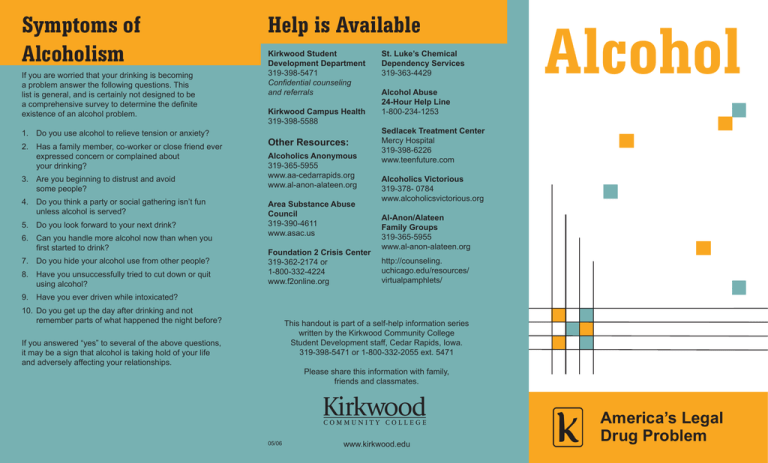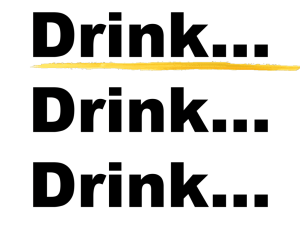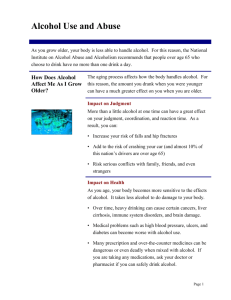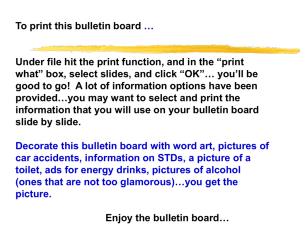Alcohol Help is Available Symptoms of Alcoholism
advertisement

Symptoms of Alcoholism If you are worried that your drinking is becoming a problem answer the following questions. This list is general, and is certainly not designed to be a comprehensive survey to determine the definite existence of an alcohol problem. 1. Do you use alcohol to relieve tension or anxiety? 2. Has a family member, co-worker or close friend ever expressed concern or complained about your drinking? 3. Are you beginning to distrust and avoid some people? 4. Do you think a party or social gathering isn’t fun unless alcohol is served? 5. Do you look forward to your next drink? 6. Can you handle more alcohol now than when you first started to drink? 7. Do you hide your alcohol use from other people? 8. Have you unsuccessfully tried to cut down or quit using alcohol? Help is Available Kirkwood Student Development Department 319-398-5471 Confidential counseling and referrals Kirkwood Campus Health 319-398-5588 Other Resources: Alcoholics Anonymous 319-365-5955 www.aa-cedarrapids.org www.al-anon-alateen.org Area Substance Abuse Council 319-390-4611 www.asac.us Foundation 2 Crisis Center 319-362-2174 or 1-800-332-4224 www.f2online.org St. Luke’s Chemical Dependency Services 319-363-4429 Alcohol Abuse 24-Hour Help Line 1-800-234-1253 Alcohol Sedlacek Treatment Center Mercy Hospital 319-398-6226 www.teenfuture.com Alcoholics Victorious 319-378- 0784 www.alcoholicsvictorious.org Al-Anon/Alateen Family Groups 319-365-5955 www.al-anon-alateen.org http://counseling. uchicago.edu/resources/ virtualpamphlets/ 9. Have you ever driven while intoxicated? 10. Do you get up the day after drinking and not remember parts of what happened the night before? This handout is part of a self-help information series written by the Kirkwood Community College Student Development staff, Cedar Rapids, Iowa. 319-398-5471 or 1-800-332-2055 ext. 5471 If you answered “yes” to several of the above questions, it may be a sign that alcohol is taking hold of your life and adversely affecting your relationships. Please share this information with family, friends and classmates. 05/06 www.kirkwood.edu America’s Legal Drug Problem Alcohol America’s Legal Drug Problem Methamphetamine, cocaine, and heroin are indisputably dangerous drugs. The rapid and profound addiction to and dependence upon these drugs has been well documented through countless case studies. Children in our society are informed and warned of the perilous results of experimenting with these drugs, as well they should be, since more than 4,000 Americans die each year as a result of using and abusing methamphetamine, cocaine or heroin. Conversely, perhaps because of its legal status, alcohol is not generally considered a dangerous drug. In fact, its addictive power is not even implied in any of the $2 billion worth of advertising purchased by the alcohol industry each year. School children rarely learn more than 14 million American men, women and children are dependent upon or addicted to alcohol, or that between 110,000 and 120,000 people die each year as a direct result of alcohol abuse. Those Abusing Alcohol Statistical studies have determined that about 11 percent of the drinking population accounts for more than 50 percent of the total alcohol consumed. In the United States, 33 percent of adults do not use alcohol at all, and the 56 percent who drink moderately are considered responsible drinkers. The percentage of problem drinkers and alcoholics in the total population exceeds 10 million people and crosses all strata of age, gender, race, income level and religion. Research has not found a single cause of alcoholism. Physiological, psychological and sociological influences likely converge for a given person to become an alcoholic. Research has shown evidence that some people are genetically predisposed to becoming alcoholic. Myths About Alcohol 1. I can drink all the beer or wine I want – it’s not like drinking hard liquor. A 12-ounce can of beer and a 5-ounce glass of wine have the same amount of alcohol as a shot of whiskey. 2. Drinking does not affect my grades. A clear relationship exists between alcohol use and grade point average among college students. Students who receive Ds or Fs drink three times as much as those who earn As. 3. Having a few drinks won’t affect my driving. Nonsense! In Iowa, a person is considered legally drunk if his or her blood alcohol level equals or exceeds 0.08 percent. However, studies show that even a professional driver’s abilities diminish sharply at levels as low as 0.03 to 0.05 percent, which is equal to a 150-pound person taking two drinks in one hour. Since alcohol affects judgment, people often think they are driving better than ever when actually, they are driving worse. men and women in the U.S. report that at least one of their close relatives has a drinking problem. 9. It’s impolite to tell a friend he or she is drinking too much. Maybe if we weren’t so polite we wouldn’t have so many friends with drinking problems. 10.The only way to be accepted and respected is to drink a lot. To earn the respect of others, you must have self-respect. Alcoholism leads to lack of self-respect. Facts about College Students and Drinking • Use of alcohol and other drugs is associated with the leading causes of death and injury (motor vehicle crashes, homicides and suicides) among teenagers and young adults. • Sixty percent of the women on college campuses who become infected with a sexually transmitted disease (STD) were intoxicated at the time. • 5. You’re not an alcoholic unless you drink a pint a day. Experts have concluded that how much a person drinks may be far less important than when, how and why a person drinks. Fifty percent of the criminal assaults on campus involve alcohol or other drugs. • 6. Most alcoholics are middle-aged or older. The highest proportion of drinking problems occurs among men in their early 20s. Thirty-three percent of the students who are heavy drinkers reported physical injury to themselves or others as a consequence of drinking five or more drinks in one sitting in the last two weeks. • 7. The really serious problem in our society is drug use. Right, and our number one drug problem is alcohol abuse and alcoholism. Seventy-five percent of the attempted suicides by college students are associated with the use or abuse of alcohol. • Sixty-five percent of the rapes reported at colleges involve the use of alcohol by one or both parties. • Ninety percent of the gang rapes on campus involve alcohol. 4. People who drink too much only hurt themselves. They do hurt themselves, but they also hurt their families, friends, employers and strangers on the highway. Every year, alcohol is involved in more than 50 percent of the auto accidents in this country. In addition, 60 percent of homicides, 33 percent of suicides and 65 percent of domestic violence episodes are alcohol related. 8. I don’t know any alcoholics. You may just not know that you know any alcoholics. Some of your best friends may have a drinking problem and are simply hiding it, perhaps even from themselves. Fifty-three percent of the



